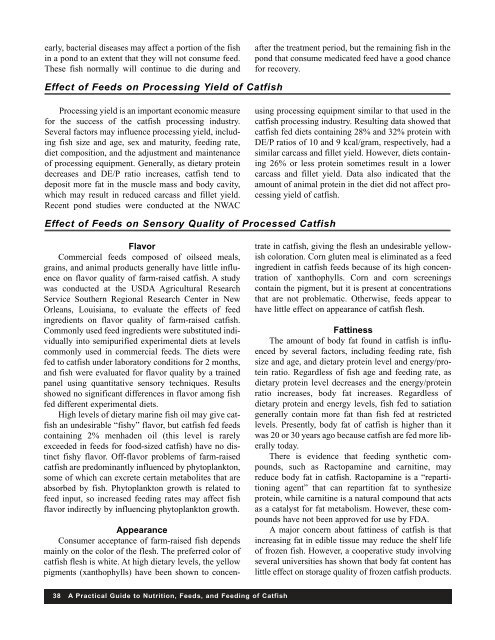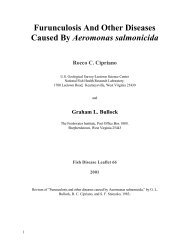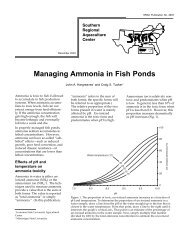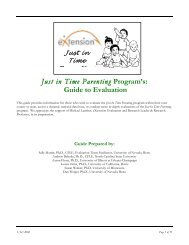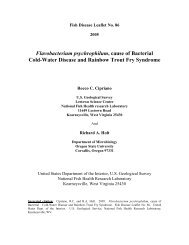A Practical Guide to Nutrition, Feeds, and ... - cop.eXtension.org
A Practical Guide to Nutrition, Feeds, and ... - cop.eXtension.org
A Practical Guide to Nutrition, Feeds, and ... - cop.eXtension.org
Create successful ePaper yourself
Turn your PDF publications into a flip-book with our unique Google optimized e-Paper software.
early, bacterial diseases may affect a portion of the fish<br />
in a pond <strong>to</strong> an extent that they will not consume feed.<br />
These fish normally will continue <strong>to</strong> die during <strong>and</strong><br />
Effect of <strong>Feeds</strong> on Processing Yield of Catfish<br />
Processing yield is an important economic measure<br />
for the success of the catfish processing industry.<br />
Several fac<strong>to</strong>rs may influence processing yield, including<br />
fish size <strong>and</strong> age, sex <strong>and</strong> maturity, feeding rate,<br />
diet composition, <strong>and</strong> the adjustment <strong>and</strong> maintenance<br />
of processing equipment. Generally, as dietary protein<br />
decreases <strong>and</strong> DE/P ratio increases, catfish tend <strong>to</strong><br />
deposit more fat in the muscle mass <strong>and</strong> body cavity,<br />
which may result in reduced carcass <strong>and</strong> fillet yield.<br />
Recent pond studies were conducted at the NWAC<br />
Effect of <strong>Feeds</strong> on Sensory Quality of Processed Catfish<br />
Flavor<br />
Commercial feeds composed of oilseed meals,<br />
grains, <strong>and</strong> animal products generally have little influence<br />
on flavor quality of farm-raised catfish. A study<br />
was conducted at the USDA Agricultural Research<br />
Service Southern Regional Research Center in New<br />
Orleans, Louisiana, <strong>to</strong> evaluate the effects of feed<br />
ingredients on flavor quality of farm-raised catfish.<br />
Commonly used feed ingredients were substituted individually<br />
in<strong>to</strong> semipurified experimental diets at levels<br />
commonly used in commercial feeds. The diets were<br />
fed <strong>to</strong> catfish under labora<strong>to</strong>ry conditions for 2 months,<br />
<strong>and</strong> fish were evaluated for flavor quality by a trained<br />
panel using quantitative sensory techniques. Results<br />
showed no significant differences in flavor among fish<br />
fed different experimental diets.<br />
High levels of dietary marine fish oil may give catfish<br />
an undesirable “fishy” flavor, but catfish fed feeds<br />
containing 2% menhaden oil (this level is rarely<br />
exceeded in feeds for food-sized catfish) have no distinct<br />
fishy flavor. Off-flavor problems of farm-raised<br />
catfish are predominantly influenced by phy<strong>to</strong>plank<strong>to</strong>n,<br />
some of which can excrete certain metabolites that are<br />
absorbed by fish. Phy<strong>to</strong>plank<strong>to</strong>n growth is related <strong>to</strong><br />
feed input, so increased feeding rates may affect fish<br />
flavor indirectly by influencing phy<strong>to</strong>plank<strong>to</strong>n growth.<br />
Appearance<br />
Consumer acceptance of farm-raised fish depends<br />
mainly on the color of the flesh. The preferred color of<br />
catfish flesh is white. At high dietary levels, the yellow<br />
pigments (xanthophylls) have been shown <strong>to</strong> concen-<br />
38 A <strong>Practical</strong> <strong>Guide</strong> <strong>to</strong> <strong>Nutrition</strong>, <strong>Feeds</strong>, <strong>and</strong> Feeding of Catfish<br />
after the treatment period, but the remaining fish in the<br />
pond that consume medicated feed have a good chance<br />
for recovery.<br />
using processing equipment similar <strong>to</strong> that used in the<br />
catfish processing industry. Resulting data showed that<br />
catfish fed diets containing 28% <strong>and</strong> 32% protein with<br />
DE/P ratios of 10 <strong>and</strong> 9 kcal/gram, respectively, had a<br />
similar carcass <strong>and</strong> fillet yield. However, diets containing<br />
26% or less protein sometimes result in a lower<br />
carcass <strong>and</strong> fillet yield. Data also indicated that the<br />
amount of animal protein in the diet did not affect processing<br />
yield of catfish.<br />
trate in catfish, giving the flesh an undesirable yellowish<br />
coloration. Corn gluten meal is eliminated as a feed<br />
ingredient in catfish feeds because of its high concentration<br />
of xanthophylls. Corn <strong>and</strong> corn screenings<br />
contain the pigment, but it is present at concentrations<br />
that are not problematic. Otherwise, feeds appear <strong>to</strong><br />
have little effect on appearance of catfish flesh.<br />
Fattiness<br />
The amount of body fat found in catfish is influenced<br />
by several fac<strong>to</strong>rs, including feeding rate, fish<br />
size <strong>and</strong> age, <strong>and</strong> dietary protein level <strong>and</strong> energy/protein<br />
ratio. Regardless of fish age <strong>and</strong> feeding rate, as<br />
dietary protein level decreases <strong>and</strong> the energy/protein<br />
ratio increases, body fat increases. Regardless of<br />
dietary protein <strong>and</strong> energy levels, fish fed <strong>to</strong> satiation<br />
generally contain more fat than fish fed at restricted<br />
levels. Presently, body fat of catfish is higher than it<br />
was 20 or 30 years ago because catfish are fed more liberally<br />
<strong>to</strong>day.<br />
There is evidence that feeding synthetic compounds,<br />
such as Rac<strong>to</strong>pamine <strong>and</strong> carnitine, may<br />
reduce body fat in catfish. Rac<strong>to</strong>pamine is a “repartitioning<br />
agent” that can repartition fat <strong>to</strong> synthesize<br />
protein, while carnitine is a natural compound that acts<br />
as a catalyst for fat metabolism. However, these compounds<br />
have not been approved for use by FDA.<br />
A major concern about fattiness of catfish is that<br />
increasing fat in edible tissue may reduce the shelf life<br />
of frozen fish. However, a cooperative study involving<br />
several universities has shown that body fat content has<br />
little effect on s<strong>to</strong>rage quality of frozen catfish products.


